Emergency Responders Call Up NOAA's CAMEO
NOAA scientists have developed a software product called Computer-Aided Management of Emergency Operations (CAMEO), which is widely used by emergency specialists around the world to plan for and respond to hazardous materials incidents. Using CAMEO, emergency workers can quickly characterize chemical hazards, predict potential effects of chemical releases on people and the environment, and get response recommendations.
Marine shipping is an essential part of our nation's trade, and NOAA provides weather forecasts and warnings, tide and current readings, and nautical charts to help keep mariners safe. This work is all part of NOAA's mission to support safe shipping and commerce.
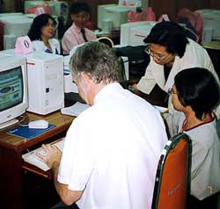
An EPA trainer helps students as they learn to use CAMEO in Bangkok, Thailand. Photo courtesy of the U.S. Environmental Protection Agency.
NOAA also works to meet another challenge associated with safe shipping: the hazardous chemical cargo carried by ships traveling to and from U.S. seaports. NOAA scientists have developed a software product, Computer-Aided Management of Emergency Operations (CAMEO), to plan for and respond to hazardous materials incidents.
Using CAMEO, emergency workers can quickly characterize chemical hazards, predict potential effects of chemical releases on people and the environment, and get response recommendations. The software interacts directly with population and facility data from the U.S. Census Bureau, the U.S. Environmental Protection Agency, and the U.S. Geological Survey. Since its development over 20 years ago, CAMEO has become the most widely used chemical emergency response and planning tool in the United States. It has been translated into French and Spanish. In addition, the United Nations Environment Programme has adopted CAMEO and provides CAMEO training in 50 countries.

CAMEO windows display a listing of the chlorine stored at a water treatment facility (upper left), reactivity hazard information for chlorine (lower left), and the area potentially affected by a chlorine release from the facility (foreground). Click image for larger view and full caption.
Over the past two decades, CAMEO has brought first responders from an era in which they gleaned information from maps and reference books spread out on the hoods of their trucks to a time when up-to-date, comprehensive information on chemical plumes, toxicity risks, and susceptibility of chemical mixtures to burn or explode can be displayed with a few strokes on a computer keyboard. This article looks ahead, to consider how CAMEO will evolve over the coming 20 years.
The Next 20 Years
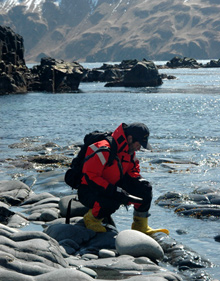
NOAA spill scientists work out of their Seattle office and also in the field. Here, a NOAA scientist checks an Alaskan shoreline for oil beached after a 2004 oil spill. Click image for larger view.
So what can we expect from CAMEO during the next 20 years?
NOAA's vision for the next few years is to develop a "next generation" version of CAMEO that takes full advantage of modern computing technology to better meet the evolving needs of responders. In the future, NOAA scientists will need to evolve CAMEO to meet many new challenges, from chemical terrorism to large-volume chemical shipments.
Potential Chemical Terrorism
Historically, NOAA has focused on hazards from accidental releases of industrial chemicals. Since 9/11, concern has grown about potential terrorist attacks against ships carrying chemicals or port facilities holding hazardous cargos. While there has not yet been a terrorist attack on a cargo vessel, terrorists have attacked other kinds of ships, as well as land-based chemical facilities.
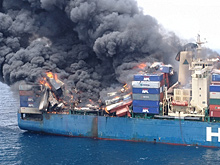
The aftermath of a March 2006 explosion of hazardous cargo on a container ship. The Congressional Research Service estimates that more than 100,000 marine shipments (54 million tons) of chemicals that could cause mass casualties passed through U.S. ports in 2003, the latest year for which data were available. Click image for larger view and image credit.
In response to concerns about deliberate chemical releases, NOAA recently completed new software tools for predicting fire and explosion hazards from industrial chemicals and has begun work on additional tools. One such tool is a CAMEO dataset of information and response recommendations for chemical weapons of mass destruction. The other is a modeling tool for emergency planners who need to characterize the hazards from dangerous chemicals transported along roadways and stored at chemical facilities.
Electronic Data Systems
The U.S. Coast Guard is improving its ability to electronically track both vessels and cargo. For example, cargo manifests are now submitted electronically by incoming ships to the Coast Guard's National Vessel Movement Center. NOAA and the U.S. Coast Guard have begun work on methods to link information in CAMEO directly to Coast Guard databases. This linkage will make it possible for responders to quickly access response-related information about chemicals onboard a vessel of concern.
Cargo Containerization
Since the 1980s, the amount of marine cargo carried in large shipping containers has expanded tremendously. Now, most general cargo is carried on containerships and typical containerships carry inventories that include hazardous chemicals.
One challenge for U.S. Coast Guard cargo inspectors is determining whether substances that could react dangerously together are located within the same container or in adjacent containers. CAMEO already includes a tool for predicting the reactivity of chemicals that are accidentally mixed. That tool will be enhanced to make it easier for cargo inspectors, using cargo manifests and vessel stowage plans, to quickly find and resolve potential reactivity problems on a containership.
Large-volume Chemical Shipments
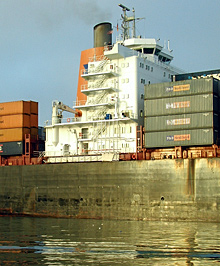
Stacks of cargo containers on the deck of a containership; many more containers are stacked in the ship’s hold. Click image for larger view and image credit.
Hazardous chemicals are sometimes carried in large volumes on chemical tankers and barges. Large chemical releases are possible from such vessels. NOAA has begun work on a tool that will allow users to quickly "scale the hazard." This means predicting the approximate extent of the hazard area—for a range of release volumes of a given chemical. Knowing the scale of the potential hazard helps U.S. Coast Guard personnel who are responsible for vessel and port security.
Responder Needs
Most emergency responders are not trained chemists. They are trained and experienced at responding to emergencies, including search and rescue operations and emergency medicine, as well as chemical incidents. For responders, software and other tools must be easy and quick to use. From the beginning, NOAA involved first responders in designing CAMEO. Today, NOAA's spill scientists also research the work of emergency responders and planners to better understand their needs for tools and information, and they ask firefighters and U.S. Coast Guard responders to test development versions of the software so that usability problems can be found and fixed.
Conclusion
Perhaps CAMEO's impact on emergency response during the past 20 years was best summed up by a former firefighter, now an emergency manager: "One thing that CAMEO gave us was a safer environment to work in. I am happy to say that we have never lost a firefighter at a hazmat incident while we have been using CAMEO."
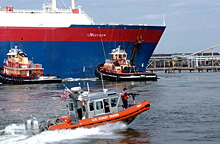
A U.S. Coast Guard vessel escorts an LNG bulk carrier into Boston Harbor. Click image for larger view and image credit.
The challenge for the NOAA team developing CAMEO is to maintain a successful track record during the next 20 years and beyond. The initiatives described above are just some of the ways that NOAA is working to ensure that CAMEO continues to evolve to meet the needs of emergency responders.
One thing won't change: NOAA's overall goal for CAMEO is to provide accurate information needed by emergency decision makers working to keep the public and responders safe. That goal will remain unchanged, and NOAA will continue to collaborate with other agencies and first responders to meet it.
Works Consulted
Muller, G. (1999). Intermodal Freight Transportation, 4th ed. Washington, DC: Eno Transportation Foundation and Intermodal Association of North America.
Parformak, P. W. & Fritelli, J. (2005). Marine Security of Hazardous Chemical Cargo. Washington, DC: Congressional Research Service.
